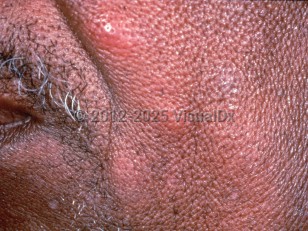Kimura disease
Alerts and Notices
Important News & Links
Synopsis

Kimura disease, also known as eosinophilic hyperplastic lymphogranuloma, is a chronic inflammatory disorder of unknown etiology. It is characterized by the development of unilateral and painless cervical lymphadenopathy and/or subcutaneous lymphoid masses, usually on the head and neck.
Kimura disease is most common in Asia. Patients with Kimura disease are usually young adults, although the disease may present during adolescence, particularly in Chinese and Japanese males. Men are affected more often than women. About 15%-20% of patients with Kimura disease also have nephrotic syndrome, although the pathophysiologic basis for this association is unclear, and acute glomerulonephritis is seen in about one-half of patients.
It is thought that the disease may represent a hypersensitivity or autoimmune process, but regardless, the end result is clearly an abnormal proliferation of lymphoid follicles and vascular endothelium. Of note, angiolymphoid hyperplasia with eosinophilia (ALHE) and Kimura disease, once thought to be disease variants, are now recognized to be separate, distinct diseases with specific clinical and histologic features.
Pediatric Patient Considerations:
Rare in children.
Kimura disease is most common in Asia. Patients with Kimura disease are usually young adults, although the disease may present during adolescence, particularly in Chinese and Japanese males. Men are affected more often than women. About 15%-20% of patients with Kimura disease also have nephrotic syndrome, although the pathophysiologic basis for this association is unclear, and acute glomerulonephritis is seen in about one-half of patients.
It is thought that the disease may represent a hypersensitivity or autoimmune process, but regardless, the end result is clearly an abnormal proliferation of lymphoid follicles and vascular endothelium. Of note, angiolymphoid hyperplasia with eosinophilia (ALHE) and Kimura disease, once thought to be disease variants, are now recognized to be separate, distinct diseases with specific clinical and histologic features.
Pediatric Patient Considerations:
Rare in children.
Codes
ICD10CM:
L92.8 – Other granulomatous disorders of the skin and subcutaneous tissue
SNOMEDCT:
399894006 – Kimura disease
L92.8 – Other granulomatous disorders of the skin and subcutaneous tissue
SNOMEDCT:
399894006 – Kimura disease
Look For
Subscription Required
Diagnostic Pearls
Subscription Required
Differential Diagnosis & Pitfalls

To perform a comparison, select diagnoses from the classic differential
Subscription Required
Best Tests
Subscription Required
Management Pearls
Subscription Required
Therapy
Subscription Required
References
Subscription Required
Last Reviewed:09/17/2017
Last Updated:10/08/2017
Last Updated:10/08/2017
Kimura disease

